In our DigiView Software, Advanced Triggers are specified in terms of SIGNALS. After assigning channels to signal names, you can configure the advanced trigger condition based on the defined signals (see: Signals). Most engineers will find it easier to reference the condition as it relates to the circuit's function rather than remembering which channels of the analyzer were used to connect to specific signals in the circuit.
DigiView's advanced trigger configuration screen centers the user's focus on function; making it much easier to quickly analyze and modify a very complex trigger condition. The following graphic is an example of an advanced trigger condition for the DV3500.
(also see: Trigger Match Types, Sequencer )

To access Trigger configuration options, click the Project Settings button on the tool bar, then select the Hardware Triggers tab.
Example of an Advanced Trigger Configuration for Model DV3500:
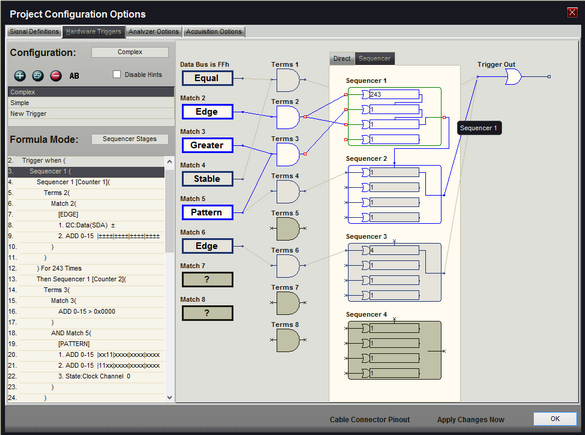
The Advanced Trigger configuration screen implements a dual-mode (GUI and text), schematic-like approach to configuring the matches, sequencers and trigger output from a single window. A text window shows the 'formula' for the configuration while the 'schematic' shows the flow. These two sections update together to provide two distinct views of the configuration. Multiple trigger configurations can also be selected and created using the selection area in the upper left corner of this screen.
Trigger Configuration Selection
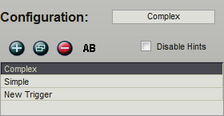
Multiple trigger configurations can be created and stored in the DigiView Data File. Use the selection box to quickly chose another trigger
configuration. After making a selection, click the "apply" button on the bottom of the screen to send the new configuration to the analyzer. To create, clone, delete or rename a configuration use the buttons above the selection box.
Trigger Formula (left portion of screen)
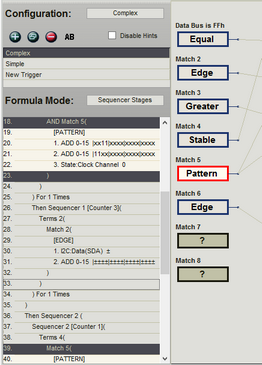
The formula presents a summary of the complete configuration. Since this summary can be quite involved with a complex trigger condition, each section will "highlight" as items in the graphical section are selected or the mouse moves over them. The formula will automatically scroll to bring the highlighted section into view while working in the graphical area of the configuration. In the image above, the summary of "MATCH 5" is brought into view as Match 5 is selected (shown with a red outline above).
Schematic (right portion of screen)

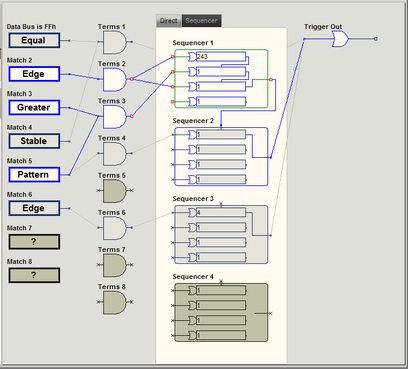
This area is where the actual configuration is accomplished. For clarification, the graphical area is divided by two major paths: Direct (non-sequenced) pathways and Sequenced pathways. Select viewing of each path by using the appropriate Tab at the top of this area. Note: The Match configuration and Term connections are common to both pathways and will always display.
Every trigger configuration starts with a match condition and ends with Trigger Out, so the work flow is designed from left to right, starting with the Match Types (see: Trigger Match Types).
Connections
Auto Connect
When the very first Match type is selected and the match condition has been specified, the match will automatically route graphically to the Trigger Out. For the DV3 series, this means it will route to TERMS 1, then the DIRECT (NON-Sequenced) option and then to Trigger Out.
This automatic function is only performed if no other connections already exist. Once you have started making connections for your trigger configuration, the software will not try to "guess" your intentions, since this would hinder your work. The software allows you to manually connect or disconnect if the action is valid. Only the obvious connect and disconnects will be performed automatically.
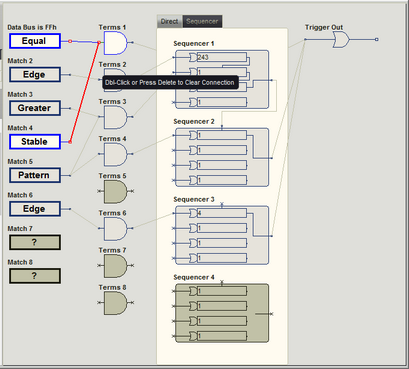
Manual Connections
Connection points will display a red square as the mouse moves over them. To Start a connection click on one of these points then move the mouse over another valid connection point and click to finish the connection. To Delete a connection, repeat the process or use the Delete Key or Double-Click when the connection highlights in the editing color (red). To Cancel a connection before the second point has been selected, click in the open area between valid connection points or use the Escape Key or the Delete Key.
NOTE: The graphical connections in the trigger configuration directly correspond to the physical circuit connections in the hardware, making this screen an overview of the resulting logic in the analyzer's hardware.
See the Following Sections: